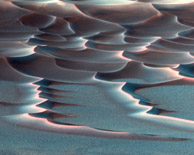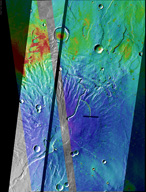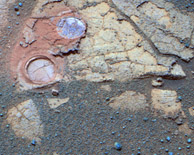Workshop Overview
**Note: This workshop took place in April 2006Workshop Goals and Format

A few geoscience departments have a long tradition of teaching undergraduate courses in planetary geoscience. Most don't, due either to limitations in faculty expertise or constraints imposed by the curriculum. With diverse and readily accessible new Mars datasets now available for use by all geologists, however, such limitations and constraints should no longer prevent geoscience faculty from exploring the educational benefits of using planetary examples in their courses.
Our aim in this workshop was to promote an approach of Mars across the curriculum so that more students could have experience with the wealth of new data from Mars. By bringing together Mars researchers and undergraduate geoscience faculty with interest or expertise in planetary geoscience, we aimed to catalyze an effort to make resources, assignments, and activities readily available on line to faculty across the country to integrate into a wide variety of commonly taught undergraduate courses. The workshop format included:

- Catalyst presentations: Short presentations by Mars researchers to catalyze discussion on development of ideas for new assignments and activities for undergraduate courses. PowerPoint files from these presentations are part of the on-line resource collection.
- Poster presentations: Poster presentations by workshop participants showing examples of assignments and activities that have already been developed and could be used as examples in commonly taught undergraduate courses. PDF files of these posters will become part of the on-line resource collection, and presenters will submit the activities to the on-line assignments and activities collection.
- Discussion: Plenary and small-group discussion of opportunities for broadly disseminating data-based Mars examples and promoting integration of Mars examples into a variety of undergraduate courses.
- Email List: A email list for workshop participants promoted discussion before and after the workshop.
Expectations
By applying to the workshop, participants agreed to do the following if accepted for the workshop:
- present a poster illustrating at least one example of an assignment or activity using Mars data that could be integrated into an undergraduate course or give a short presentation on an aspect of Mars geoscience to catalyze development of ideas for new assignments and activities for undergraduate courses
- contribute to on-line resource collections prior to and following the workshop
- prepare in advance for workshop discussions via readings, discussion or other activities developed by workshop leaders
- participate fully in the entire workshop
- serve as leaders in follow-on activities leading to broad implementation
Dates
The workshop began with dinner on Thursday evening, April 27, 2006 at Arizona State University in Tempe, Arizona and ended Saturday evening April 29. Participants must attend all sessions. Participants should plan to arrive at Phoenix Sky Harbor Airport no later than 4:00 PM on April 27th and return home on Sunday, April 30th.
Eligibility and Application

The workshop was limited to 30 participants, and the final list of participants was established with the goal of assembling a group that included leaders in Mars research and leaders in undergraduate geoscience education who have demonstrated experience or interest in planetary geoscience. The final participant list also reflected the full spectrum of institutional settings and teaching experiences, as well as diversity of participants. Applicants must either hold a faculty position at a college or university or a research position in planetary geoscience. We cannot accept applications from pre-college teachers. Application must be completed on line by February 15, 2006. Applicants were notified of selection by February 20. For additional information, visit general information for workshop participants.
Travel
The workshop was held at Arizona State University in Tempe, Arizona. Participants made their own way to Tempe in time for the first workshop event at 6 pm on Thursday, April 27. The campus in Tempe is located about 20 minutes drive from Phoenix Sky Harbor Airport.

